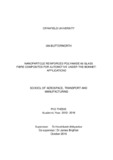JavaScript is disabled for your browser. Some features of this site may not work without it.
| dc.contributor.advisor | Abhyankar, Hrushikesh | |
| dc.contributor.advisor | Brighton, James L. | |
| dc.contributor.author | Butterworth, Ian | |
| dc.date.accessioned | 2023-03-28T16:07:37Z | |
| dc.date.available | 2023-03-28T16:07:37Z | |
| dc.date.issued | 2016-10 | |
| dc.identifier.uri | https://dspace.lib.cranfield.ac.uk/handle/1826/19366 | |
| dc.description.abstract | This work focus on an engine oil pan application which expects component materials operate at elevated temperatures due to returning oil heating up during operation. Mechanical properties of thermoplastic composites are known to be temperature dependent with performance losses elevated temperatures. A pilot study was conducted to benchmark the current state-of-the-art glass reinforced polyamide materials at elevated temperatures to address a gap in this knowledge. Experiments included tensile, 3-point flexural, and gas gun impact where conducted at elevated temperatures 23°C, 65°C, 90°C and 120°C. Experimental results demonstrated the trade-off in the mechanical properties of the two materials especially when one of the materials had been impact modified with an elastomer (PA66-GF-E). PA66-GF-E mechanical and impact performance can be considered fit of purpose as a suitable material for an oil pan application but is more expensive. As an extra compounding step is required to graft the elastomer to the PA66 matrix. Literature studies into replacements for the elastomer suggested nanoparticles as they can be compounded at the same time as the GF and in turn eliminate secondary compounding costs. Six 3-phase nanocomposite where then compounded using a twin screw extruder. Additions of OMMT and SiO2where done in 2, 3 and 4wt.% for each nanocomposite. Testing of the 3-phase nanocomposites indicated the GF reduction has reduced mechanical strength in all results, but still demonstrates each nanomaterial and volume has been successful. Thermomechanical testing and aging suggests an optimised SiO2 in wt.% of 2 or 3 could replace an elastomer as an impact modifier. OMMT grades did not have a significant improvement to over the SiO2 grades to consider suitable for the oil pan application. However this work does builds a strong case for further work to continue developing 3-phase nanocomposites by improving the compounding setup. | en_UK |
| dc.language.iso | en | en_UK |
| dc.rights | © Cranfield University, 2015. All rights reserved. No part of this publication may be reproduced without the written permission of the copyright holder. | |
| dc.subject | Nanocomposites | en_UK |
| dc.subject | oil pan | en_UK |
| dc.subject | melt compounding | en_UK |
| dc.subject | twin screw extruder | en_UK |
| dc.subject | injection moulding | en_UK |
| dc.subject | thermo-mechanical testing | en_UK |
| dc.subject | impact testing | en_UK |
| dc.subject | thermal aging | en_UK |
| dc.title | Nanoparticle reinforced polyamide 66 glass fibre composites for automotive under-the-bonnet-applications. | en_UK |
| dc.type | Thesis | en_UK |
| dc.description.coursename | PhD in Transport Systems | en_UK |
